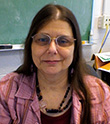Dr. Judith Cebra-Thomas
Associate Professor, Developmental biology and general biology. IACUC Committee Chair. Allied Health Coordinator.

Office Hours
M: 12 pm (noon) - 1 pm
T: 4 - 5 pm
W: 5 - 6 pm
F: 12:30 - 2:30 pm
Comments: Other office hours by appointment.
Education:
B.S., Johns Hopkins University
Ph.D., Washington University
Courses Taught:
BIOL 100 – General Biology
BIOL 108H – Freshman Honors Seminar (Topic: Bioethics)
BIOL 263 – Cell Biology Laboratory
BIOL 465 – Developmental Biology
BIOL 472 – Senior Seminar (Topic: Stem Cells & Human cloning)
UNIV 101 – Freshman Seminar
Areas of Specialization:
Developmental biology, bone formation, developmental basis for evolutionary change, cell and molecular biology.
Research Interest(s):
The goal of my research is to understand the processes that control the development of an organism from an embryo. Changes in those processes result in changes in the shape of the adult organism, and can lead to the production of novel body plans (and new species of organisms). A good example of this is the turtle; the turtle shell is made of 50 bones that appear to be unique – they do not appear in any other existing vertebrate. In addition, the turtle shell appears suddenly in the fossil record. For these reasons, turtle shell is considered to be an evolutionary novelty.
Currently, my students and I are investigating the developmental origin of the cells that give rise to the bony shell of the turtle. The bones of the turtle shell do not form like the bones in the trunk of other vertebrates, instead they form like those of the vertebrate skull. Skull bones are produced by migrating, multipotential cells known as neural crest cells. Our results suggest that there is a unique population of neural crest cells in turtle embryos that is responsible for forming the shell. The significance of this research is two-fold: first, it addresses the mechanism of cell differentiation, and second, it seeks to provide an explanation for the appearance of a novel structure that has provided a challenge to evolutionary theory.
Selected Publication(s):
Cebra-Thomas JA, Betters* E, Yin M, Plafkin* C, McDow* K, and Gilbert SF. 2007. Evidence that a late-emerging population of trunk neural crest cells forms the plastron in the turtle Trachemys scripta. Evolution and Development 9:267-277.
Gilbert SF, Bender* G. Betters* E , Yin M, and Cebra-Thomas JA. 2007. The contribution of neural crest cells in the formation of the nuchal bone and plastron of the turtle shell. Integrative and Comparative Biology ; published online June 1, 2007; doi: 10.1093/icb/icm020.
Gilbert SF, Cebra-Thomas JA, and Burke AC. 2007. “How the turtle gets its shell,” In Biology of Turtles: Structures to Strategies (J Wyneken, ed.). CRC Press, Boca Raton. In press.
Cebra-Thomas , J., Tan*, F., Sistla*, S., Estes, E., Bender*, G., Kim*, C., and Gilbert, S. F. 2005. How the turtle forms its shell: A paracrine hypothesis of carapace formation. J. Experimental Zoology/ Molecular and Developmental Evolution 304B: 158 – 169.
Cebra-Thomas J.A., Brommer*, J., Gardner*, R., Lam*, G.K., Sheipe*, H.A., and Gilbert, S.F. 2003. T-box gene products are required for mesenchymal induction of epithelial branching in the embryonic mouse lung, Developmental Dynamics 226:82-90.
* denotes undergraduate researcher.